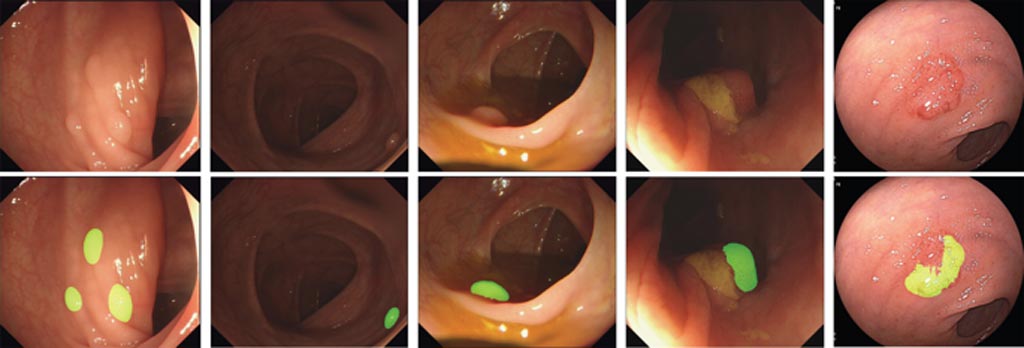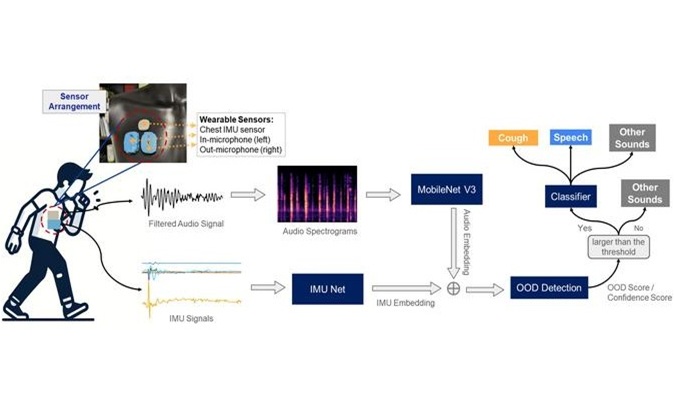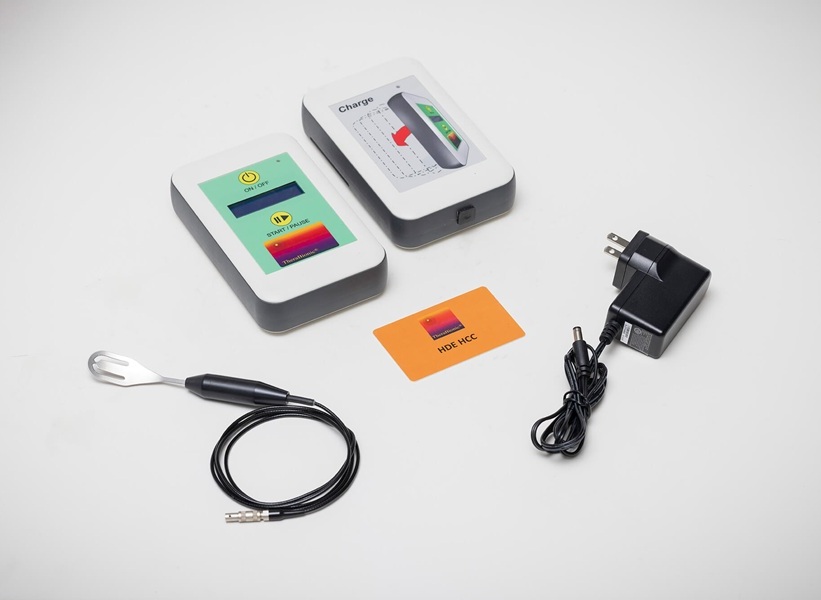New AI Algorithm Enhances Polyp Detection in Colonoscopy Procedures
|
By HospiMedica International staff writers Posted on 23 Nov 2018 |

Image: The Wision AI algorithm highlights polyps on the monitor, enhancing detection (bottom) (Photo courtesy of Shanghai Wision AI).
Researchers at Shanghai Wision AI Co., Ltd. (Shanghai, China), a developer of computer-aided diagnostic algorithms and systems to improve the accuracy and effectiveness of diagnostic imaging, have announced results of a study validating a novel machine-learning algorithm that improves detection of adenomatous polyps during colonoscopy. The AI algorithm is built on the same network architecture that is used to develop self-driving cars and is designed to enable “self-driving” in colonoscopy procedures.
The Wision AI algorithm was validated on large, prospectively developed datasets collected independently from the training dataset that were several-fold larger than the training dataset. This more rigorous validation approach utilized by Wision AI is meant to increase the performance of the algorithm in real-world clinical settings.
The algorithm was developed using 5,545 images (65.5% containing polyps and 34.5% without polyps) from the colonoscopy reports of 1,290 patients. Experienced endoscopists annotated the presence of polyps in all images used in the development dataset, and the algorithm was then validated on four independent datasets: two sets for image analysis (A and B) and two sets for video analysis (C and D). According to the study’s key findings, validation on dataset A, which included 27,113 images from patients undergoing colonoscopy at the Endoscopy Center of Sichuan Provincial People’s Hospital, found a per-image-sensitivity of 94.4% and a per-image-specificity of 95.9%. The per-image-sensitivity in a subset of 1,280 images with polyps that are typically hard to detect was 91.7%.
Validation on dataset B, based on a public database of 612 colonoscopy images acquired from the Hospital Clinic of Barcelona, found a per-image-sensitivity of 88.2%. The use of this dataset allowed for generalization of the validation data to a broader patient population. Validation on dataset C included a series of colonoscopy videos containing 138 polyps, found a per-image sensitivity of 91.6% among 60,914 frames of video, and a per-polyp sensitivity of 100%. Validation on dataset D, which contained 54 colonoscopy videos without any polyps, found a per-image-specificity of 95.4% among 1,072,483 frames. The total processing time for each image frame was 76.8 milliseconds, including preprocessing and displaying times before and after execution of the deep-learning algorithm. Implementation in a real-time system resulted in a processing rate of 30 frames per second with Nvidia Titan X GPUs.
Based on these findings, the researchers concluded that the automatic polyp-detection system based on deep learning has a high overall performance in both colonoscopy images and real-time videos.
“The results of this study demonstrate the power of our rigorous approach to developing deep-learning algorithms, which utilizes distinct datasets for training and validation and results in high levels of specificity and sensitivity that have the potential to improve diagnostic screening methods that are known to reduce disease risk, improve health outcomes and save lives,” said JingJia Liu, CEO at Wision AI.
Related Links:
Shanghai Wision AI
The Wision AI algorithm was validated on large, prospectively developed datasets collected independently from the training dataset that were several-fold larger than the training dataset. This more rigorous validation approach utilized by Wision AI is meant to increase the performance of the algorithm in real-world clinical settings.
The algorithm was developed using 5,545 images (65.5% containing polyps and 34.5% without polyps) from the colonoscopy reports of 1,290 patients. Experienced endoscopists annotated the presence of polyps in all images used in the development dataset, and the algorithm was then validated on four independent datasets: two sets for image analysis (A and B) and two sets for video analysis (C and D). According to the study’s key findings, validation on dataset A, which included 27,113 images from patients undergoing colonoscopy at the Endoscopy Center of Sichuan Provincial People’s Hospital, found a per-image-sensitivity of 94.4% and a per-image-specificity of 95.9%. The per-image-sensitivity in a subset of 1,280 images with polyps that are typically hard to detect was 91.7%.
Validation on dataset B, based on a public database of 612 colonoscopy images acquired from the Hospital Clinic of Barcelona, found a per-image-sensitivity of 88.2%. The use of this dataset allowed for generalization of the validation data to a broader patient population. Validation on dataset C included a series of colonoscopy videos containing 138 polyps, found a per-image sensitivity of 91.6% among 60,914 frames of video, and a per-polyp sensitivity of 100%. Validation on dataset D, which contained 54 colonoscopy videos without any polyps, found a per-image-specificity of 95.4% among 1,072,483 frames. The total processing time for each image frame was 76.8 milliseconds, including preprocessing and displaying times before and after execution of the deep-learning algorithm. Implementation in a real-time system resulted in a processing rate of 30 frames per second with Nvidia Titan X GPUs.
Based on these findings, the researchers concluded that the automatic polyp-detection system based on deep learning has a high overall performance in both colonoscopy images and real-time videos.
“The results of this study demonstrate the power of our rigorous approach to developing deep-learning algorithms, which utilizes distinct datasets for training and validation and results in high levels of specificity and sensitivity that have the potential to improve diagnostic screening methods that are known to reduce disease risk, improve health outcomes and save lives,” said JingJia Liu, CEO at Wision AI.
Related Links:
Shanghai Wision AI
Latest AI News
Channels
Critical Care
view channel
Origami Robots to Deliver Medicine Less Invasively and More Effectively
Delivering medicine to ulcers or other internal sites often requires invasive procedures that can disrupt surrounding tissues and lengthen recovery times. Traditional magnetic actuators used in soft robotics... Read more
Improved Cough-Detection Technology Aids Health Monitoring
Coughing serves as an important biomarker for tracking a variety of conditions and can help monitor the progress of respiratory diseases or predict when someone’s asthma is being exacerbated.... Read moreSurgical Techniques
view channel
Novel Glue Prevents Complications After Breast Cancer Surgery
Seroma and prolonged lymphorrhea are among the most common complications following axillary lymphadenectomy in breast cancer patients. These postoperative issues can delay recovery and postpone the start... Read more
Breakthrough Brain Implant Enables Safer and More Precise Drug Delivery
Delivering medication directly to specific regions of the brain has long been a major challenge in treating neurological disorders. Current implants and infusion systems typically reach only one or two... Read morePatient Care
view channel
Revolutionary Automatic IV-Line Flushing Device to Enhance Infusion Care
More than 80% of in-hospital patients receive intravenous (IV) therapy. Every dose of IV medicine delivered in a small volume (<250 mL) infusion bag should be followed by subsequent flushing to ensure... Read more
VR Training Tool Combats Contamination of Portable Medical Equipment
Healthcare-associated infections (HAIs) impact one in every 31 patients, cause nearly 100,000 deaths each year, and cost USD 28.4 billion in direct medical expenses. Notably, up to 75% of these infections... Read more
Portable Biosensor Platform to Reduce Hospital-Acquired Infections
Approximately 4 million patients in the European Union acquire healthcare-associated infections (HAIs) or nosocomial infections each year, with around 37,000 deaths directly resulting from these infections,... Read moreFirst-Of-Its-Kind Portable Germicidal Light Technology Disinfects High-Touch Clinical Surfaces in Seconds
Reducing healthcare-acquired infections (HAIs) remains a pressing issue within global healthcare systems. In the United States alone, 1.7 million patients contract HAIs annually, leading to approximately... Read moreHealth IT
view channel
Printable Molecule-Selective Nanoparticles Enable Mass Production of Wearable Biosensors
The future of medicine is likely to focus on the personalization of healthcare—understanding exactly what an individual requires and delivering the appropriate combination of nutrients, metabolites, and... Read moreBusiness
view channel
Philips and Masimo Partner to Advance Patient Monitoring Measurement Technologies
Royal Philips (Amsterdam, Netherlands) and Masimo (Irvine, California, USA) have renewed their multi-year strategic collaboration, combining Philips’ expertise in patient monitoring with Masimo’s noninvasive... Read more
B. Braun Acquires Digital Microsurgery Company True Digital Surgery
The high-end microsurgery market in neurosurgery, spine, and ENT is undergoing a significant transformation. Traditional analog microscopes are giving way to digital exoscopes, which provide improved visualization,... Read more
CMEF 2025 to Promote Holistic and High-Quality Development of Medical and Health Industry
The 92nd China International Medical Equipment Fair (CMEF 2025) Autumn Exhibition is scheduled to be held from September 26 to 29 at the China Import and Export Fair Complex (Canton Fair Complex) in Guangzhou.... Read more
















